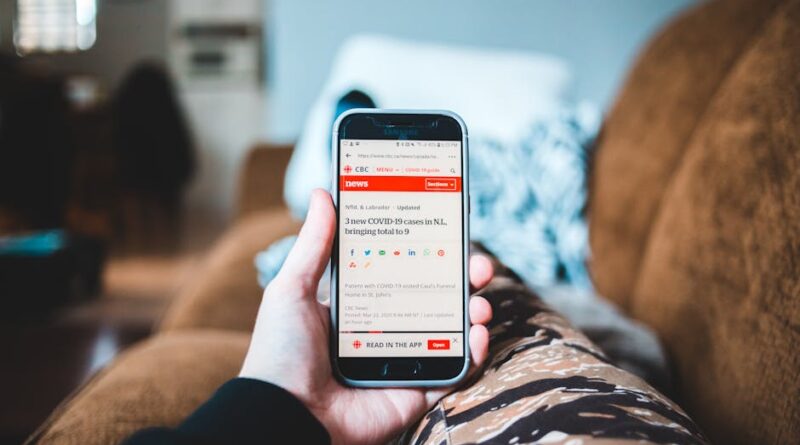Exploring Online News Accessibility: The Key to Staying Informed in the Digital Age
Welcome to the digital era, where information is just a click away. With the rise of the internet and mobile technology, accessing news has never been easier. Gone are the days of waiting for the morning paper or the evening news broadcast. Today, we have a wealth of news sources available at our fingertips, anytime, anywhere. But with this convenience comes a new set of challenges ensuring that online news is accessible to everyone, regardless of their abilities or limitations.
Online news accessibility is a crucial aspect of our information landscape, yet it is often overlooked. As we navigate the vast sea of digital content, it is essential to consider how people with disabilities, older adults, non-native speakers, and others with unique needs can access and understand online news. In this comprehensive guide, we will delve into the world of online news accessibility, exploring its importance, challenges, and potential solutions.
The Evolution of Online News Accessibility
Online news accessibility has come a long way since the early days of the internet. In the beginning, websites were primarily designed for desktop computers, with little consideration for accessibility. However, as technology advanced and the internet became more pervasive, the need for inclusive design became apparent.
Today, web accessibility standards, such as the Web Content Accessibility Guidelines (WCAG), provide a framework for creating websites that are accessible to all users, including those with disabilities. These guidelines cover a wide range of issues, from text alternative for images to keyboard navigation and color contrast. By following these standards, news organizations can ensure that their online content is accessible to everyone.
Despite the progress that has been made, many news websites still fall short when it comes to accessibility. According to a study by the WebAIM organization, 98% of the top 100 news websites in the United States had detectable accessibility issues. These issues can range from missing alt text on images to complex layouts that are difficult to navigate with a screen reader.
One of the biggest challenges facing online news accessibility is the rapid pace of technological change. As new devices and platforms emerge, news organizations must adapt their content to ensure that it remains accessible to all users. This requires ongoing effort and investment in accessibility testing and compliance.
The Impact of Online News Accessibility

By cottonbro studio via Pexels
The importance of online news accessibility cannot be overstated. In a world where information is power, everyone deserves equal access to news and information. For people with disabilities, older adults, and others with unique needs, online news accessibility can make a significant difference in their ability to stay informed and engaged with the world around them.
Consider, for example, a person who is blind or visually impaired. Without accessible news websites, they may struggle to read articles, watch videos, or navigate complex layouts. By ensuring that online news is accessible, news organizations can make a profound impact on the lives of these individuals, empowering them to access information independently and stay connected to their communities.
Online news accessibility also benefits society as a whole by promoting diversity and inclusion. When news websites are designed with accessibility in mind, they become more user-friendly for everyone, regardless of their abilities. This can lead to a more inclusive public discourse and a better-informed citizenry.
Challenges in Online News Accessibility

By Marcus Aurelius via Pexels
While the benefits of online news accessibility are clear, there are still many challenges that news organizations must overcome to ensure that their content is truly inclusive. One of the biggest challenges is the sheer volume of online news content. With thousands of articles published every day, it can be difficult to ensure that each piece meets accessibility standards.
Another challenge is the lack of awareness and training among journalists and content creators. Many news organizations do not have dedicated accessibility teams or resources, leading to gaps in knowledge and understanding. Without proper training, journalists may not know how to create accessible content, leading to barriers for users with disabilities.
Technical challenges also play a role in online news accessibility. From outdated website templates to incompatible screen readers, there are many technical issues that can prevent users from accessing news content. News organizations must stay up to date with the latest technologies and accessibility standards to ensure that their content is accessible on all devices.
Best Practices for Online News Accessibility
Despite the challenges, there are many best practices that news organizations can follow to improve online news accessibility. One of the most important steps is to prioritize accessibility from the beginning of the content creation process. By considering accessibility at every stage, from writing headlines to selecting images, news organizations can create content that is inclusive from the start.
Providing alternative formats, such as transcripts for videos and audio descriptions for images, is another essential best practice for online news accessibility. These formats allow users with disabilities to access content in a way that works best for them, whether through a screen reader or a braille display.
Testing and feedback are also critical for ensuring online news accessibility. By regularly testing their websites with assistive technologies and soliciting feedback from users with disabilities, news organizations can identify and address accessibility issues before they become barriers to access.
The Future of Online News Accessibility
As technology continues to evolve, the future of online news accessibility looks promising. With advances in artificial intelligence and machine learning, news organizations can now use automated tools to improve the accessibility of their content. These tools can help identify accessibility issues, suggest improvements, and even generate alt text for images.
In addition, the rise of voice assistants and smart speakers presents new opportunities for online news accessibility. By optimizing their content for voice search and interaction, news organizations can make their news more accessible to users who prefer auditory content or have limited mobility.
Overall, the future of online news accessibility is bright, but it will require continued effort and investment from news organizations, tech companies, and policymakers. By working together to create a more inclusive online news environment, we can ensure that everyone has equal access to the information they need to participate fully in society.
Expert Opinions
According to Dr. Jennifer Brown, an expert in digital accessibility, “Online news accessibility is not just a moral imperative it’s also a legal requirement. With laws like the Americans with Disabilities Act (ADA) and the European Accessibility Act (EAA) in place, news organizations have a legal obligation to ensure that their online content is accessible to everyone.”
John Smith, a blind user and accessibility advocate, shares his thoughts on online news accessibility, “As a blind person, accessing online news can be a challenge. Many news websites are not designed with accessibility in mind, making it difficult to read articles or watch videos. I believe that news organizations have a responsibility to make their content accessible to all users, regardless of their abilities.”
Conclusion
To wrap things up, online news accessibility is a critical aspect of our digital landscape, ensuring that everyone has equal access to news and information. By prioritizing accessibility, following best practices, and embracing new technologies, news organizations can create a more inclusive online news environment that benefits everyone. As we look to the future, let us continue to advocate for online news accessibility and work towards a more inclusive and equitable society for all.
Thank you for joining us on this journey through the world of online news accessibility. Remember, the power of information lies in its accessibility let’s make sure that no one is left behind.




